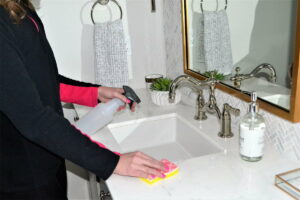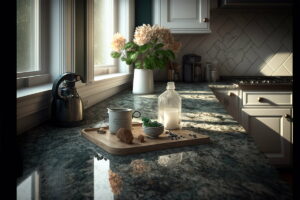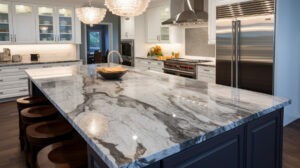When it comes to kitchen counters, those who opt for either marble or granite tend to be more satisfied than others. Marble and granite both look fantastic, are easy to clean, and stand the test of time. However, there are some differences of note between these two stones.
Aesthetic Differences
Marble and granite are completely natural stones. However, there are unique stones and minerals within both marble and granite. Commercial granite is metamorphic or igneous stone, meaning it is primarily made of silica, quartz, mica, and feldspar. Granite stone is packed tightly, producing a granular aesthetic along the surface. Some granite has bits of color and vein-like patterns while another granite is solid. You can find granite in all sorts of different colors ranging from the especially dark variety to those that are quite light in hue.
Alternatively, marble’s composition is either sedimentary or metamorphic, mainly consisting of calcite. Certain marble is comprised of quartzite or a stone that is quartz-based. The marble dubbed as “green” consists of the mineral known as serpentine. Marble has a comparably smooth surface and plenty of vein-like patterns. Similar to granite, marble has different hues ranging from black to white and variations in between. The minerals within these stones ultimately determine their color. Furthermore, the location where the stone is cut from also plays a part in the color.
Installing Marble and Granite
Granite and marble counters are made and installed in the same manner. However, slabs of marble are typically smaller in size than slabs of granite. As a result, you will likely require more pieces of marble to complete your full kitchen.
Our works
[ngg src=”galleries” ids=”1,2,3,4,5″ display=”basic_thumbnail” thumbnail_crop=”0″ images_per_page=”15″ ajax_pagination=”0″ order_by=”rand()” order_direction=”DESC”]Durability
Stone counter durability is primarily determined by its makeup. The majority of marble consists of calcite. Calcite is a porous and soft mineral, meaning marble will absorb stains. A marble counter with a matte finish will help conceal etching.
Igneous granite does not mandate sealing. Furthermore, this type of granite does not etch or scratch easily. The majority of granite with dark hues will look fantastic over time, suffering minimal etching. However, granite that is light in hue will prove more vulnerable to etching and scratching.
Maintenance
Granite requires less maintenance than marble. Every granite counter but for those with primarily black stone should be quickly sealed immediately following their installation. When properly sealed, water beads along the surface of the stone. Once the water no longer beads, it is a sign the time is right to reseal the stone. Be sure to wipe any spills immediately after they occur so you do not end up with staining. Orlando Granite stone should be washed with a PH-neutral cleaning solution in order to reduce the chances of etching and removing the finish.
The marble counter should be regularly sealed with a specialized sealer specifically meant for porous stones. However, marble is that much more likely to stain even after a sealer is applied. Do your best to avoid putting acidic items such as tomato sauce, lemon juice, and red wine on your marble counters as they are likely to cause etching on the surface of the stone. While granite counters should be sealed once per year, marble counters should be sealed once per quarter.
EdStone is at Your Service
When it comes to marble and granite, no one has a better inventory than EdStone. If you are considering either of these stones, reach out to us today. You can contact EdStone by dialing (407) 973-2074 or visit us.





